The On-shelf Availability Solution Industry Analysis in Japan is estimated to be valued at USD 337.8 million in 2025 and is projected to reach USD 696.6 million by 2035, registering a compound annual growth rate (CAGR) of 7.5% over the forecast period.
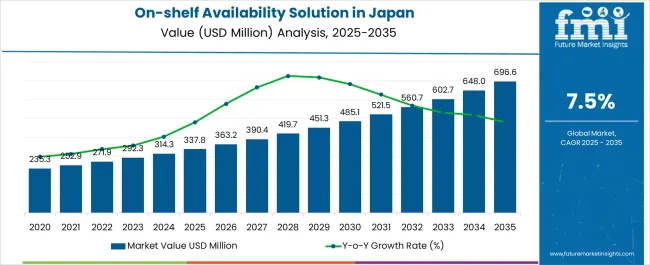
| Metric | Value |
|---|---|
| On-shelf Availability Solution Industry Analysis in Japan Estimated Value in (2025 E) | USD 337.8 million |
| On-shelf Availability Solution Industry Analysis in Japan Forecast Value in (2035 F) | USD 696.6 million |
| Forecast CAGR (2025 to 2035) | 7.5% |
The on-shelf availability solution industry in Japan is expanding steadily. Increasing focus on retail efficiency, heightened consumer expectations for product accessibility, and rising adoption of digital retail technologies are shaping current market growth. Software-driven systems are being integrated to provide real-time inventory visibility and predictive analytics.
Retailers and suppliers are adopting advanced solutions to minimize out-of-stock scenarios and improve customer satisfaction. Future outlook remains strong as omnichannel retailing, supply chain optimization, and AI-powered forecasting models continue to evolve. Government initiatives promoting digital transformation in retail are further reinforcing adoption.
Growth rationale is centered on the ability of these solutions to improve operational efficiency, reduce revenue leakage, and strengthen customer loyalty Expanding SaaS-based offerings and cloud infrastructure adoption are ensuring scalability and cost-effectiveness, which positions the market for sustained momentum across both domestic and international retail chains operating in Japan.
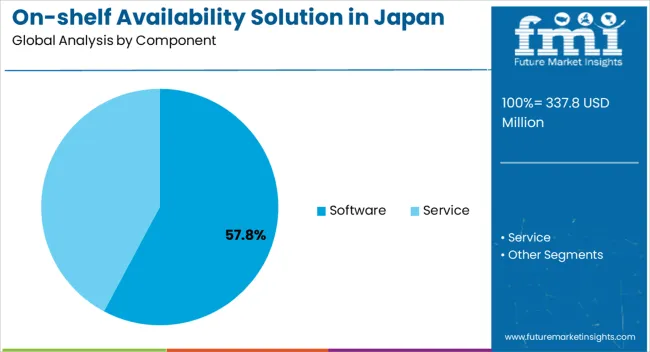
The software segment, representing 57.80% of the component category, has been leading the industry due to its ability to provide scalable, customizable, and data-driven functionalities. Adoption has been supported by growing reliance on advanced analytics and integration with existing enterprise systems. Retailers are increasingly utilizing software platforms to enable demand forecasting, shelf monitoring, and replenishment planning.
Cloud integration and API-driven adaptability have strengthened software deployment, ensuring seamless interoperability with retail ecosystems. Continuous innovation in machine learning algorithms has further enhanced predictive accuracy and real-time decision-making.
The segment’s strong position is being reinforced by cost-efficiency, faster deployment cycles, and ongoing vendor investments in R&D These advantages are expected to sustain its leadership and drive long-term adoption in the Japanese retail market.
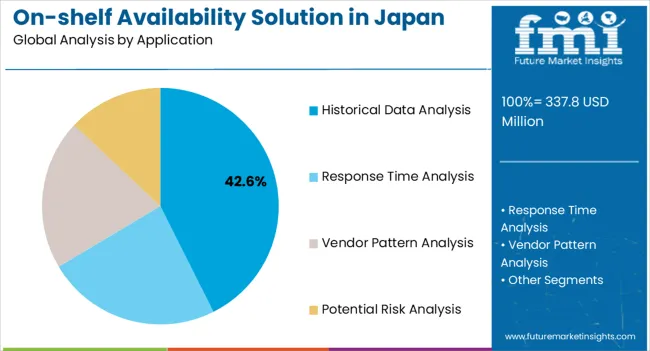
The historical data analysis segment, accounting for 42.60% of the application category, has been leading due to its pivotal role in enabling retailers to forecast demand and optimize inventory based on past performance patterns. This approach has been effective in identifying seasonal trends, sales fluctuations, and consumer preferences.
Adoption has been strengthened by retailers’ focus on improving planning accuracy and reducing inefficiencies in supply chain operations. Data-driven insights derived from historical analysis have been widely used to minimize stockouts and overstocks, thereby enhancing profitability.
Continuous improvements in analytics models and integration with advanced visualization tools have supported greater usability and decision-making efficiency Market share sustainability is expected to be reinforced by the increasing scale of retail operations in Japan and the emphasis on precision-driven inventory strategies.
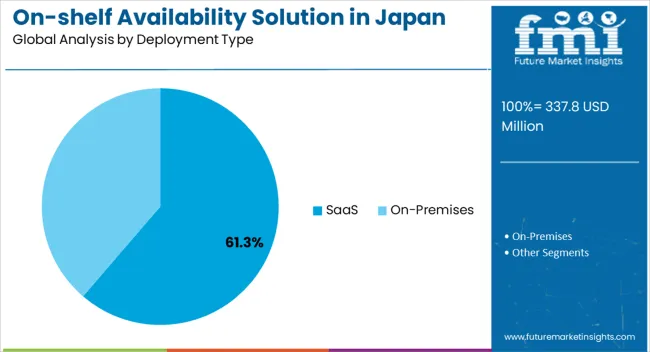
The SaaS deployment type, holding 61.30% of the deployment category, has emerged as the dominant approach due to its flexibility, scalability, and cost-efficiency. Retailers in Japan are adopting SaaS models to avoid heavy upfront capital investments while benefiting from subscription-based services that ensure regular updates and maintenance.
Cloud-based infrastructure has enabled wider accessibility, faster implementation, and seamless upgrades, which align with Japan’s broader digital transformation initiatives. SaaS deployment has also facilitated enhanced security compliance and remote operability, both of which are increasingly critical in modern retail ecosystems.
Its ability to support multi-location enterprises and deliver real-time inventory visibility has further strengthened its dominance Continued innovation by vendors in user experience, integration capabilities, and AI-powered functionalities is expected to sustain the SaaS model’s leadership across the Japanese retail sector.
| Top Component for On-shelf Availability Solution in Japan | Software |
|---|---|
| Total Value Share (2025) | 51.20% |
Software is crucial for delivering advanced data analytics capabilities. With the increasing complexity of retail operations, Japan-based firms are turning to digital solutions to evaluate massive amounts of information in real-time. These analytics assist in making informed decisions regarding inventory levels, demand forecasts, and optimizing supply chain processes. The software serves as the foundation for real-time inventory monitoring and visibility. This capability is crucial in dealing with the dynamic nature of customer demands, enabling Japanese merchants to adapt quickly to changes in product popularity and avoid stockouts or overstock problems.
| Top Application for On-shelf Availability Solution in Japan | Potential Risk Analysis |
|---|---|
| Total Value Share (2025) | 28.10% |
Modern technologies, such as IoT devices and artificial intelligence, pose additional risks associated with technology integration. Potential risk analysis helps identify and manage issues connected with incorporating new technologies into current systems without interrupting operations. With an increased reliance on digital technology, the probability of cybersecurity risks has risen. Potential risk analysis involves examining flaws in digital systems, hacking attacks, and other cyber threats to ensure the security and integrity of on-shelf availability solution.
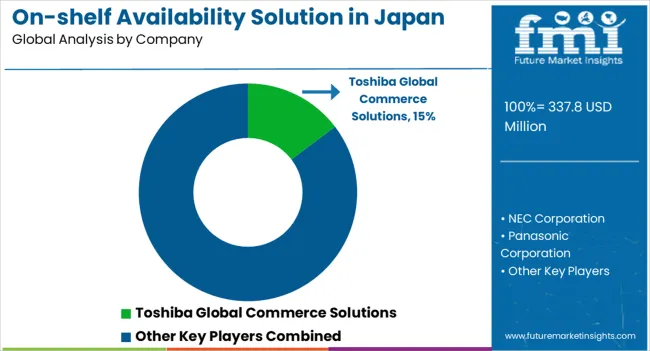
A constantly evolving interplay distinguishes the competitive landscape of on-shelf availability solution industry in Japan between technology vendors, solution developers, and industry-specific integrators. Key competitors in this industry are relentlessly pursuing innovation, with the goal of delivering cutting-edge solutions that meet the complex difficulties inherent in contemporary supply chain management.
The industry is characterized by a mix of established global firms and nimble startups, each fighting for dominance and distinction through technological superiority and strategic collaborations.
Strategies for Key Players to Tap into Potential Growth Opportunities
Recent Developments in On-shelf Availability Solution in Japan
| Attribute | Details |
|---|---|
| Estimated Industry Size in 2025 | USD 337.8 million |
| Projected Industry Size by 2035 | USD 696.6 million |
| Anticipated CAGR between 2025 to 2035 | 7.5% CAGR |
| Historical Analysis of Demand for On-shelf Availability Solution in Japan | 2020 to 2025 |
| Demand Forecast for On-shelf Availability Solution in Japan | 2025 to 2035 |
| Report Coverage | Industry Size, Industry Trends, Analysis of key factors influencing On-shelf Availability Solution Adoption in Japan, Insights on Global Players and their Industry Strategy in Japan, Ecosystem Analysis of Local and Regional Japan Manufacturers |
| Key Cities Analyzed While Studying Opportunities in On-shelf Availability Solution in Japan | Kanto, Chubu, Kinki, Kyushu & Okinawa, Tohoku, Rest of Japan |
| Key Companies Profiled | Toshiba Global Commerce Solutions; NEC Corporation; Panasonic Corporation; NCR Corporation; Fujitsu Limited; Omron Corporation; Hitachi, Ltd.; Zebra Technologies Corporation; Denso Corporation; SATO Holdings Corporation; Fanuc Corporation; Brother Industries, Ltd.; TOSHIBA TEC Corporation; CASIO COMPUTER CO., LTD.; Datalogic S.p.A. |
The global on-shelf availability solution industry analysis in Japan is estimated to be valued at USD 337.8 million in 2025.
The market size for the on-shelf availability solution industry analysis in Japan is projected to reach USD 699.5 million by 2035.
The on-shelf availability solution industry analysis in Japan is expected to grow at a 7.5% CAGR between 2025 and 2035.
The key product types in on-shelf availability solution industry analysis in Japan are software and service.
In terms of application, historical data analysis segment to command 42.6% share in the on-shelf availability solution industry analysis in Japan in 2025.






Full Research Suite comprises of:
Market outlook & trends analysis
Interviews & case studies
Strategic recommendations
Vendor profiles & capabilities analysis
5-year forecasts
8 regions and 60+ country-level data splits
Market segment data splits
12 months of continuous data updates
DELIVERED AS:
PDF EXCEL ONLINE
On-shelf Availability Solution Market Analysis - Size, Share & Forecast 2025 to 2035
Korea On-shelf Availability Solution Market – Demand & Forecast 2025 to 2035
Western Europe On-Shelf Availability Solution Market Growth – Trends & Forecast 2025 to 2035
High-Availability Server Market Size and Share Forecast Outlook 2025 to 2035
Japan Halal Tourism Market Size and Share Forecast Outlook 2025 to 2035
Japan Probiotic Yogurt Market is segmented by product type, source type, nature type, flavor type, fat content, sales channel and key city/province through 2025 to 2035.
japan Tortilla Market - Growth, Trends and Forecast from 2025 to 2035
Japan Cosmetics ODM Market Analysis - Size, Share & Trends 2025 to 2035
Japan Automotive Turbocharger Market Insights – Demand, Size & Industry Trends 2025–2035
Japan Yeast Market Insights – Demand, Size & Industry Trends 2025–2035
Japan Green and Bio-based Polyol Market Insights – Demand, Size & Industry Trends 2025–2035
Japan Natural Food Color Market Trends – Growth, Demand & Forecast 2025–2035
Japan Coated Fabrics Market Growth – Trends, Demand & Innovations 2025–2035
Japan Barite Market Growth – Trends, Demand & Innovations 2025–2035
Japan 1,4-Diisopropylbenzene Market Growth – Trends, Demand & Innovations 2025–2035
Japan Compact Construction Equipment Market Insights – Demand, Size & Industry Trends 2025–2035
Social Employee Recognition System Market in Japan - Growth & Forecast 2025 to 2035
Japan HVDC Transmission System Market - Industry Trends & Forecast 2025 to 2035
Japan Communications Platform as a Service Market Growth - Trends & Forecast 2025 to 2035
Japan Visitor Management System Market Growth - Trends & Forecast 2025 to 2035

Thank you!
You will receive an email from our Business Development Manager. Please be sure to check your SPAM/JUNK folder too.
Chat With
MaRIA